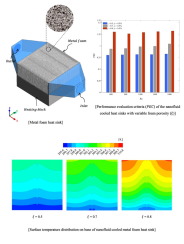Applied Thermal Engineering ( IF 6.1 ) Pub Date : 2020-03-24 , DOI: 10.1016/j.applthermaleng.2020.115231 Tehmina Ambreen , Arslan Saleem , Cheol Woo Park

|
The efficiency and the operational life of the modern high-tech electronics are essentially dependent on their effective thermal management. The metal foam heat sinks cooled by nanofluid are the potential candidate for electronic cooling applications. Therefore, this study investigates the hydrothermal and entropy generation aspects of nanofluid in an aluminum foam heat sink. The multiphase Eulerian model couple with the Darcy-Forchheimer-Brinkman model was introduced to model nanofluid in the metal foam. The performance of nanofluid dependent on substrate porosity and nanoparticles is analyzed for porosity and Reynolds number ranges of 0.5 - 0.8 and 600 - 1800, respectively. The probed nanofluid sample consisted of a 0.5% volume fraction of aqueous-based alumina nanoparticles with 40 nm diameter. The hydrothermal results are evaluated in terms of average Nusselt number, local heat transfer coefficient, pumping power and performance evaluation criteria of the heat sink. Additionally, the fluid dynamics and surface temperature distribution across the heat sink are illustrated with velocity streamlines, velocity, and thermal contours. The entropy generation aspects are discussed in the form of thermal, viscous and total entropy parameters. The results demonstrate that the heat transfer enhancement of the nanofluid is optimized by increasing the substrate porosity at the expense of the least pressure drop. The effect of media permeability on the performance of the nanofluid is more evident at a larger Reynolds number. At the Reynolds number of 1800, utilization of the nanofluid resulted in the maximum Nusselt number enhancement of 5%, 15% and 33% for the foam porosities of 0.5, 0.7 and 0.8, respectively.
中文翻译:

结合Darcy-Forchheimer-Brinkman模型和多相欧拉模型,分析泡沫铝散热器中纳米流体的水热和熵产特性
现代高科技电子设备的效率和使用寿命基本上取决于其有效的热管理。通过纳米流体冷却的金属泡沫散热器是电子冷却应用的潜在候选者。因此,本研究调查了铝泡沫散热器中纳米流体的水热和熵产生方面。引入了多相欧拉模型和Darcy-Forchheimer-Brinkman模型,以对金属泡沫中的纳米流体进行建模。纳米流体的性能取决于底物的孔隙率,而纳米颗粒的孔隙率和雷诺数范围分别为0.5-0.8和600-1800。探测的纳米流体样品由0.5%的体积分数的直径为40 nm的水基氧化铝纳米颗粒组成。根据平均努塞尔数,局部传热系数,泵送功率和散热器的性能评估标准评估水热结果。此外,通过速度流线,速度和热等高线说明了散热器上的流体动力学和表面温度分布。熵产生方面以热,粘性和总熵参数的形式讨论。结果表明,通过以最小的压降为代价增加基底孔隙率来优化纳米流体的传热增强。在较大的雷诺数下,介质渗透性对纳米流体性能的影响更加明显。在1800雷诺数下,纳米流体的利用导致最大的Nusselt数提高5%,











































 京公网安备 11010802027423号
京公网安备 11010802027423号